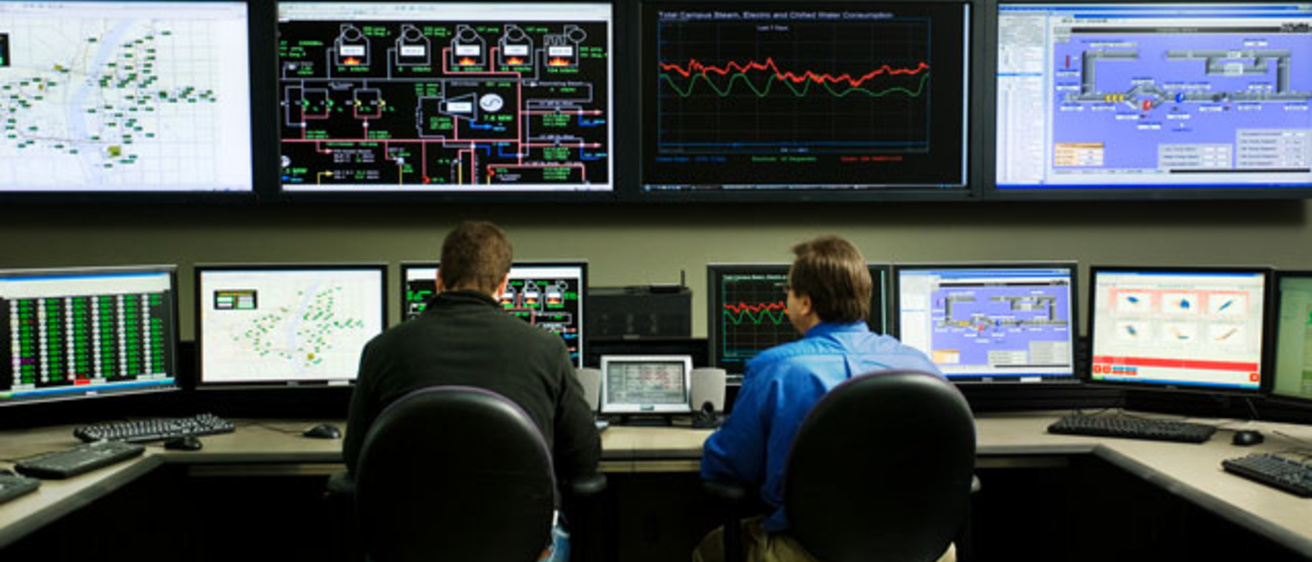
Campus Voices is a place for faculty, staff and students to share ideas, views and information about issues that matter to them personally and professionally. The opinions expressed here do not necessarily represent those of the University of Iowa. View more Campus Voices here.
You may not realize it, but as you walk across campus, beneath your feet lie miles of steam lines, water lines, fiber optics, electric ducts. Keeping those utilities running at optimum levels is key to meeting the university’s energy conservation goals, but until recently, there was the potential to get “lost in the forest” down there.
Since we brought our innovative and award-winning Energy Control Center online two years ago, we’ve been able to catch problems sooner, sometimes even before they happen, and, in the process, realize more than $500,000 a year in savings for the university.
From this room our engineers (and engineering student interns) can track the demand for energy from all parts of campus as well as energy production from our campus power plant to ensure that supply matches demand.
We also can see any red flags on the screen before a problem, such as a building air handler not ramping up in the morning, affecting the building occupants. As soon as our ECC staff notes the malfunction, a technician can be dispatched to address the issue.
But beyond the benefits of consistent comfort for workspaces and classrooms, this level of control and problem solving is going a long way to helping the university reduce its energy consumption to meet our 2020 Vision, which is to hold energy consumption at 2010 levels, irrespective of campus growth.
Facilities Management Energy Awards
Energy Control Center
2012, Effective & Innovative Award, APPA
2011, one of eight 'Favorite Green Practices in Higher Education,' Campus Technology magazine.
Energy Hawks
2010, Effective & Innovative Award, APPA
Biomass Fuel Project
2005, Effective & Innovative Award, APPA
2004, two Governor's Iowa Environmental Excellence Awards
Power Plants
2009-12, EPA Top 20 list of on-site green power users
2012, UI Research Park combined heat and power plant named one of POWER magazine’s top plants; also received American Council of Engineering Companies Engineering Excellence Award
Energy Management & Sustainability
2009, Who's Who 2009: Leaders in Energy Management and Sustainability, Buildings magazine
We will see a great deal of construction on campus over the next 18 months and beyond. Even though our new buildings are designed to exceed current energy standards by 30 percent, each new building means we must seek greater efficiencies in our existing buildings to offset our expanding facilities.
For example, an upgrade of the heating, ventilation, and air conditioning (HVAC) at Van Allen Hall allowed for the installation of individual room temperature controls. At the same time, we improved lighting and added occupancy sensors, realizing more than $32,000 per year in energy savings.
These improvements also qualified for rebates fromMidAmericanEnergy, which gave us a one-year return on our initial energy improvement investment.
The Energy Hawks program, which we started in 2009, has also helped us save energy, reduce utilities costs, and improve occupant comfort. The Energy Hawks is a team of specialists such as energy engineers, building controls technicians, maintenance personnel and operations engineers who work together to correct operational inefficiencies or system imbalances in buildings. Each year, the Energy Hawks program is expected to discover an additional $1 million in savings.
For some of us, energy management is a full-time job. But for all of us, it needs to become at least a part-time preoccupation until we’ve grown so accustomed to new habits that we do them without even thinking. Maybe you already hit the light switch on your way out the door. But how about using a power strip for all your peripheral items (desk lights, printers, coffee makers, etc.) so you can also cut electricity to all those items with one flip of the switch?
Our campus IT managers carefully manage their systems to use as little energy as possible during off hours, but they rely on you to log out or put your machine to sleep at the end of your day. There are 40,000 computers on this campus. One action repeated 40,000 times can have a big impact.
Glen Mowery is director of utilities and energy management with UI Facilities Management.
